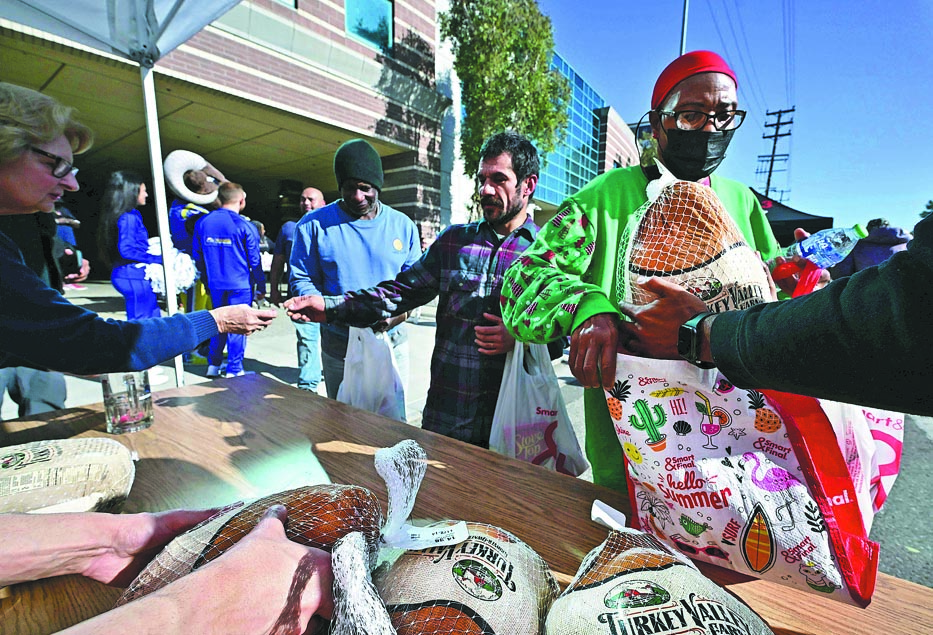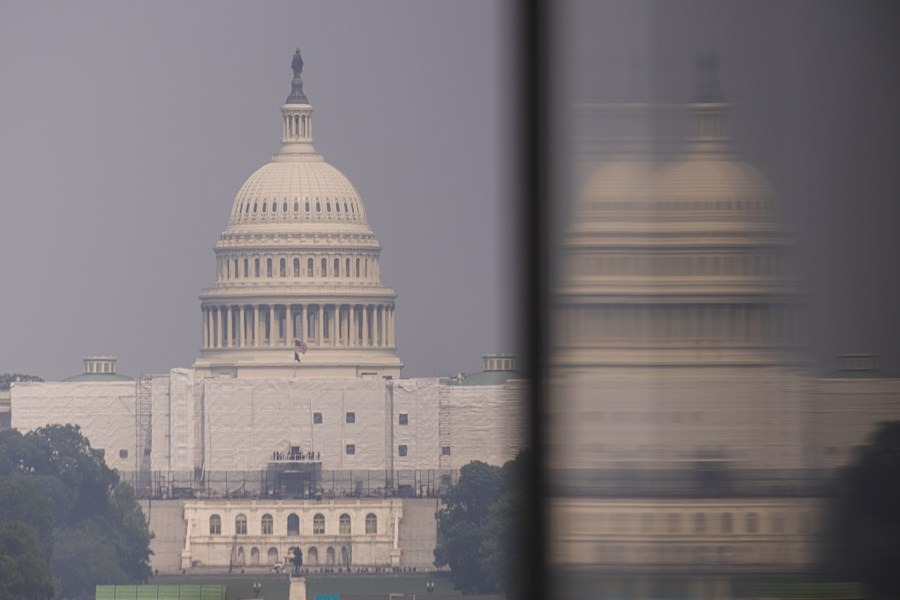Millions in US struggle to afford turkey meals
By BELINDA ROBINSON in New York | China Daily Global | Updated: 2023-11-22 09:28

Families expected to seek help before Thanksgiving amid skyrocketing prices and shrinking aid
Editor's note: With inflation in the United States causing prices to skyrocket, China Daily looks into the harsh reality of food insecurity in the country amid federal assistance cutbacks. This is starkly evident during the Thanksgiving season, which is meant to symbolize abundance, but for many serves as a brutal reminder of their struggles to afford even a simple meal.
Thanksgiving, a time-honored holiday in the United States, will see many residents eat a huge turkey meal with all the trimmings.
But as they enjoy their dinners, millions more, including families with young children, may struggle to put any food on the table in one of the richest countries in the world.
At least 44 million people, including 13 million children, were "food insecure" last year, said a report published last month by the US Department of Agriculture. This means they lacked the ability to always buy enough food to stay healthy and active.
Among low-income households, food insecurity is particularly stark in Oklahoma, Tennessee and Georgia. It is also a huge problem in big cities in California, Texas and New York. Staff members at food banks and churches in these states say demand is especially high at this time of year.
In the upscale Californian enclave of Santa Barbara, known for its chic boutique wineries and restaurants, the median household income was $89,250 in 2021, nearly $20,000 above the national rate.
However, staff members at the nonprofit Foodbank of Santa Barbara County say the number of people who need help getting a meal has risen.
The food bank's annual turkey drive provides holiday meals to local families who are struggling financially. This year, the goal was 4,000 fresh or frozen turkeys, but donations are down.
"We are currently at 6 percent of our goal," Leana Orsua, communications specialist for the Foodbank of Santa Barbara County, said. "The need is outpacing donations with only 252 birds currently donated and 10 days left before Thanksgiving."
The charitable organization has served more than 230,000 individuals this year, a 40 percent increase from last year. Orsua expects a "large number of families" will seek help in the weeks ahead.
The growing dependence on food banks comes as a Thanksgiving meal for 10 people will cost $61.17 this year, the American Farm Bureau Federation said. A 7-kilogram turkey costs around $27.35 and a 400-gram bag of stuffing mix costs $3.77.
In January, inflation caused the price of food to skyrocket 11.3 percent compared with the corresponding time last year, the US Labor Department said.
Last month, food prices fell a little, but remained stubbornly high. In the 12 months ending September, prices rose 3.7 percent.
The Foodbank of Santa Barbara County has spent 38 percent more on produce purchases this year compared with last year. This was because of "a volatile supply chain and a competitive produce market, which means that food is harder to get donated and purchases are more expensive", Orsua said.
The rising cost of food and rent is making the face of hunger in the US change, researchers say. Many in need now include households where there is at least one or two adults working full time.
White adults saw a 43 percent increase in food insecurity last year, the agriculture department said. Latinos saw a 29 percent increase and black individuals saw a 15 percent increase.
Since the 1980s, the number of food banks in the country has gone from a few hundred to 50,000 today.
Employees at food banks say while they have become more commonplace, it is important that people who can afford to do so keep donating.
Food insecurity
Last year, more than 17 million US households were food insecure, the USDA found, in addition to the 44 million already suffering. It was higher than in 2021 when it was 33.8 million. Single mothers saw a 34 percent rise compared with 2021.
On March 1, cuts to the emergency allotments for the federal government's food assistance program, the Supplemental Nutrition Assistance Program, or SNAP, left more than 30 million people in 32 states and Washington, DC, with $95 less per month. It affected the elderly, people with disabilities and others who depend on it.
"The uptick in food insecurity also occurred at a time when significant safety net enhancements that helped people through the worst of the pandemic began to end, including the expanded Child Tax Credit, universally free school meals, and, in a number of states, higher SNAP benefits," Tom Vilsack, US secretary of agriculture, said in a statement.
In Texas, where 3.6 million people get SNAP, the cuts had an immediate impact. The North Texas Food Bank said it had prepared for a surge in demand, but added that they had already been coping with an increase since early last year.
Jeff Smith, senior communications manager for the North Texas Food Bank, said the food bank has seen a 15 percent increase in meals delivered to neighbors in North Texas since March last year. This means the food bank and its feeding network of more than 400 food pantries and organizations are providing access to about 12 million meals each month.
"Food insecurity is a complex issue, but feeding our neighbors' facing hunger is not," Smith said. "We are helping to ensure that our neighbors don't have to choose between having access to nutritious food or paying for other living expenses."
Republicans in Congress have made slashing SNAP a top priority. In May, they negotiated the addition of specific work requirements for SNAP recipients to be put into the debt ceiling deal that was struck with President Joe Biden.
Newly elected House Speaker Mike Johnson has thrown his support behind conservative senators that want to reduce the welfare program, even though it helps feed 42 million low-income people in the country.
The delayed 2023 Farm Bill legislation, which governs agriculture and nutrition programs, is passed once every five years. It recently got a one-year extension.
The bill allocates $1.5 trillion over 10 years. SNAP makes up 80 percent of the bill's cost, and its recipients will continue to get benefits through Sept 30 next year.
In Iowa, Republicans in the state legislature passed a bill this year to restrict families from receiving SNAP if they have liquid assets of more than $15,000. This includes a farm, tractor or car, but not a house. The bill passed 58 to 41.
In contrast, New Jersey was the first state in the country to pass legislation that gave SNAP recipients $95 extra each month after the emergency allotments ended.
In March, Biden launched the White House Challenge to End Hunger and Build Healthy Communities. It came a year after he held the first White House conference on hunger, nutrition and health since 1973. The Biden administration has pledged $8 million to end hunger.
Free distribution
In New York City, about 45 retired women in coats and scarves to keep the cold out sat on white folding chairs waiting patiently outside the Full Gospel Assembly Church one recent afternoon.
Organizers from the church brought out donated boxes of carrots, potatoes, fruit and tinned food and laid them out on a table as they did each week. In the run-up to the holidays, they also gave away turkeys.
The women engaged in small talk as they waited for their number to be called to go up and get some free food. Many waved and said "Hi" to the familiar faces they saw at church each week getting groceries.
More than 2.2 million people in New York are facing hunger or food insecurity, including 633,790 children, charity Feeding America said.
City Relief, an organization founded in 1989, provides meals from mobile vans at several locations across the city and in New Jersey.
Corey Hayes, creative director at City Relief, said he has also seen demand increase among individuals and families this year, as people juggle the rising cost of rent and food.
"The hot meals we provide are becoming more and more important as many people have less money to spend on food," he said.
























